Last Updated on March 10, 2025 by Owen McGab Enaohwo

When you’re running a business, unexpected challenges inevitably arise. While some are easy to figure out, with clear root causes and solutions, others are not. These problems can become more challenging as the business expands and more people join. That’s why it’s essential to look beyond the surface of the problem and why it’s happening before you can truly fix it.
One effective way to do that is with a root cause analysis. This proven process lets you strategically dig deeper to find and resolve the main issues. In this article, you’ll learn everything needed to conduct a root cause analysis and make your business run smoothly and profitably.
To get you right on top of getting control of your business, sign up for SweetProcess. It’s software that helps you quickly identify problems as they pop up and also before they do. You don’t need a credit card to start.
Table of Contents
Benefits of Conducting Root Cause Analysis for Your Business
11 Free Root Cause Analysis Templates
Key Components of an RCA Document
How to Create and Manage Your RCA Using SweetProcess
Tips for Performing an Effective Root Cause Analysis
5 Root Cause Analysis Examples to Inspire Your Team
Streamline Your RCA Process With SweetProcess
What Is Root Cause Analysis?
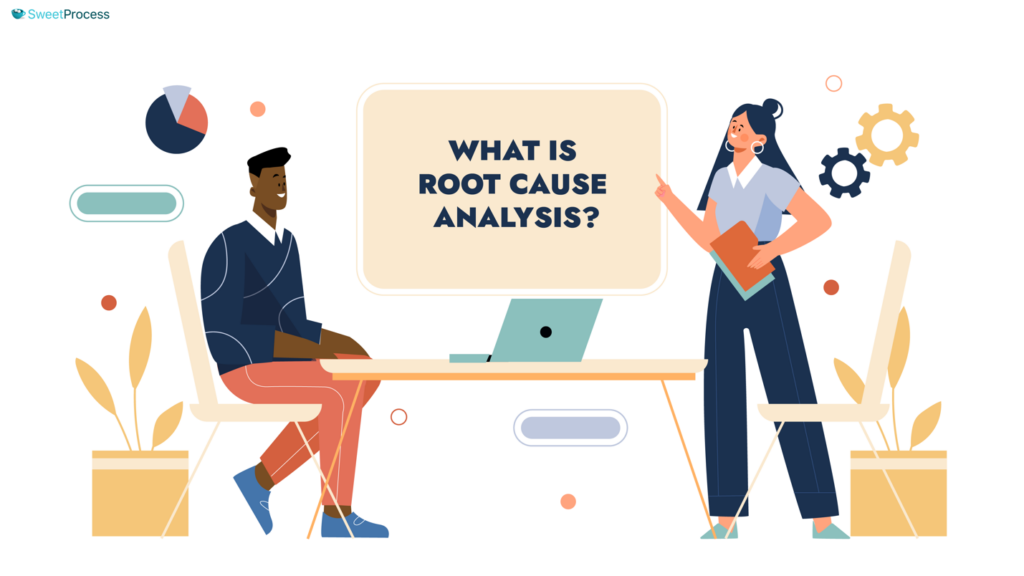
A Root Cause Analysis (RCA) is a systematic process to identify the underlying cause of a problem, event, or situation. It entails a detailed examination of what contributed to the issue, identifying the root cause(s), and implementing corrective actions to prevent similar problems from recurring.
In conducting an RCA, you’ll first clearly articulate the issue or event being analyzed, collect relevant information, including facts, observations, and witness statements, brainstorm potential causes and categorize them into different levels, analyze and prioritize causes, identify the root cause(s), develop corrective actions, and finally implement and monitor solutions.
Implementing an RCA in your business will significantly improve operations. For example, if sales are always dropped every festive period, you might explore why instead of offering more promotions. Possible explanations include shipping delays, seasonal rebranding, fluctuations in market demand, or competitor price cuts. By understanding the root cause, you can create better future strategies. You’ll have permanent solutions to problems, reduced recurrence of issues, increased efficiency, and enhanced learning. The benefits will be discussed in detail shortly. In the meantime, if you need RCA software that gives you all of these benefits, kindly, sign up for SweetProcess.
Benefits of Conducting Root Cause Analysis for Your Business

Practical root cause analysis is a game-changer for organizations seeking to elevate their quality standards and drive continuous improvement. Uncovering the underlying causes of problems enables targeted solutions and paves the way for various benefits. Conducting RCA offers numerous benefits to your businesses, including:
Identifies Underlying Issues
RCA identifies defects and primary causes of problems by uncovering fundamental problems in your systems, technologies, or processes. When facing the same issues repeatedly, an RCA identifies the real problem and forms the solution’s foundation. It makes you spot challenges that may not be immediately apparent. When this is done, you can address both symptoms and underlying causes. In addition, the risk of misdiagnosing problems is eliminated, ensuring that solutions target the correct issues.
Prevents Recurrence of Problems
By addressing root causes, RCA prevents problems from recurring, as it plays a critical role in risk management. By identifying the root causes of potential risks or failures, you can proactively implement preventive measures to reduce the impact of problems. Preventing repeat failures minimizes downtime and reduces the impact on the operations of your business. When there’s a reduced occurrence of problems, your processes, equipment, and systems become reliable.
Enhances Operational Efficiency
RCA helps identify inefficiencies and opportunities for process improvements. Eliminating unnecessary steps and activities reduces waste and optimizes resource utilization, which leads to enhanced operational efficiency, increased productivity, and better resource allocation.
Reduce Cost
Implementing root cause analysis (RCA) can significantly reduce organizations’ costs. By identifying and addressing the underlying causes of problems, RCA helps eliminate unnecessary expenses associated with repeated errors, defects, and downtime. This proactive approach minimizes the need for costly repairs and replacements and eliminates inefficiencies and rework, leading to improved cost savings.
Improves Team Collaboration

RCA encourages a collaborative work environment that promotes teamwork and cross-functional collaboration. By bringing together individuals from different backgrounds and expertise, RCA promotes a complete understanding of problems and their underlying causes.
Through root cause analysis training, team members develop essential skills, such as communication, active listening, and problem-solving. As teams work together to identify and address root causes, they build trust, share knowledge, and leverage each other’s strengths.
Supports Continuous Improvement
A Root Cause Analysis (RCA) is a powerful tool for supporting continuous organizational improvement. By identifying and addressing root causes, RCA helps eliminate recurring problems, reduce inconsistencies, and improve overall performance.
As a catalyst for ongoing improvement, an RCA helps you understand the factors contributing to problems. It also enables you to implement preventive measures and make informed decisions to enhance processes, workflows, and efficiency. This cycle of continuous improvement builds a culture of innovation and excellence.
Enhances Safety Measures
A well-executed RCA minimizes the risk of accidents, equipment failures, and environmental hazards by identifying and addressing underlying causes. Thorough incident reporting and investigation ensure that issues are properly analyzed and that corrective actions lead to lasting safety improvements. Companies that prioritize root cause analysis not only enhance workplace safety but also build a culture of continuous improvement and accountability.
By integrating RCA with strategic frameworks like SWOT Analysis, businesses can strengthen their decision-making, improve overall performance, and maintain a competitive edge.
11 Free Root Cause Analysis Templates

A root cause analysis template is a customizable document that guides you in identifying the underlying causes of a problem. It typically includes:
Issue Description: Details of the problem, including when it occurred, who discovered it, and its impact.
Timeline: A chronological list of events leading up to, during, and after the incident.
Personnel: Identification of team members involved in the analysis, their methods, and reporting plans.
Root Cause: Findings and root cause determination supported by relevant data.
Solutions: Actionable solutions to prevent the problem from recurring.
Here are 11 free root cause analysis templates you can use to tackle problems in your business.
1) Simple Root Cause Analysis Template
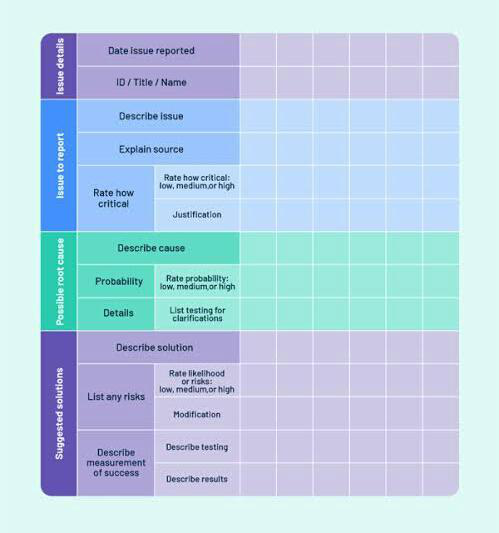
The simple root cause analysis template is a basic template suitable for straightforward problems. It includes a problem description, root cause identification, and corrective actions. This template is easy to use and requires minimal training, making it perfect for teams new to RCA.
This template’s simplicity allows teams to quickly identify and address problems, making it an excellent choice for small-scale issues. Additionally, it can be used as a starting point for more complex problems, allowing teams to drill down to the root cause gradually.
Download the Simple Root Cause Analysis Template
2) Project Management Root Cause Analysis Template
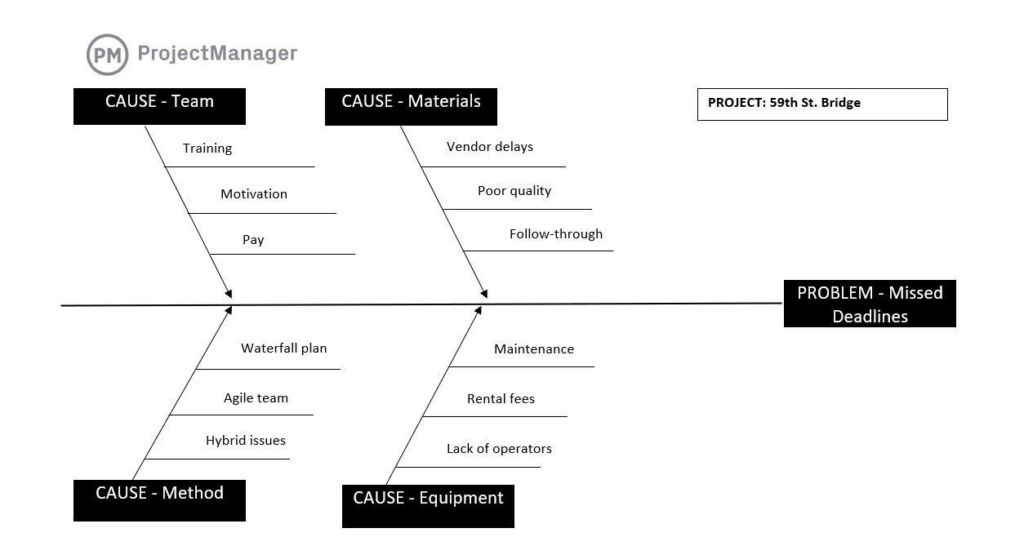
The project management root cause analysis template is designed for project managers to identify and address project-related issues. It includes a project overview, problem description, root cause identification, corrective actions, and lessons learned.
This template enables project managers to analyze and resolve issues promptly, ensuring project timelines and budgets are met. It also allows managers to identify potential roadblocks, develop backup plans, and ensure project completion.
Download the Project Management RCA Template
3) The Pareto Root Cause Analysis Template

The Pareto analysis template is valuable for identifying the most common problems or causes. Based on the 80/20 rule, it helps organizations focus on the vital few causes, prioritize efforts, and simplify complex issues.
Use the template to identify the problem, collect data, categorize causes, and create a Pareto analysis chart. Analyze the chart to identify the categories accounting for most issues.
Download the Pareto Root Cause Analysis Template
4) Six Sigma Root Cause Analysis Template
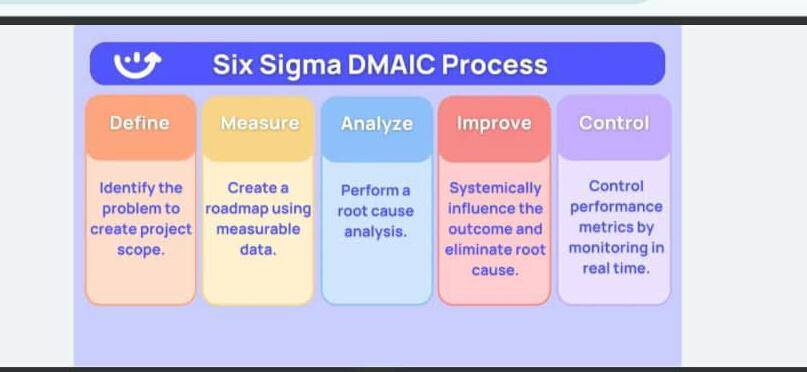
This template is used in Six Sigma initiatives to identify and eliminate defects. It includes a problem description, root cause identification, data analysis, corrective actions, and verification and validation.
This template is ideal for organizations seeking to improve root cause analysis process quality and reduce defects. Using it, teams can collect and analyze data, identify patterns and trends, and develop practical solutions to eliminate defects.
Download the Six Sigma Root Cause Analysis Template
5) 5 Whys Root Cause Analysis Template
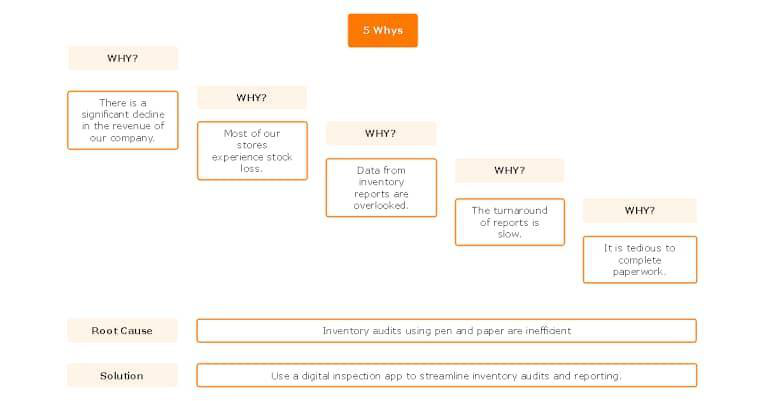
The 5 Whys root cause analysis template is a simple template that asks “why” five times to drill down to the root cause. It includes a problem description, five “why” questions, root cause identification, and corrective actions. This template is easy to use and encourages teams to think critically about the problem; by asking “why” five times, teams can gradually drill down to the root cause, ensuring that they address the underlying issue rather than just its symptoms. Also, this template promotes a culture of curiosity and critical thinking, enabling teams to develop a deeper understanding of the problem.
Download the 5 Whys RCA Template
6) Ishikawa / Fishbone Root Cause Analysis Template
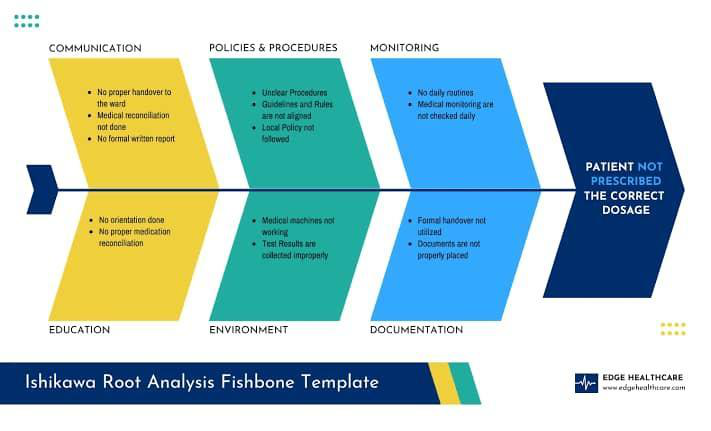
The Ishikawa/fishbone root cause analysis template is a visual template that uses a fishbone diagram to identify causes and effects. It includes a problem description, fishbone diagram, root cause identification, and corrective actions. This template helps teams visualize the problem and identify potential causes. Teams can use a fishbone diagram to categorize potential root causes analysis tools into different categories, such as equipment, materials, or personnel.
Download the Fishbone Diagram RCA Template
7) Accident Investigation Root Cause Analysis Template
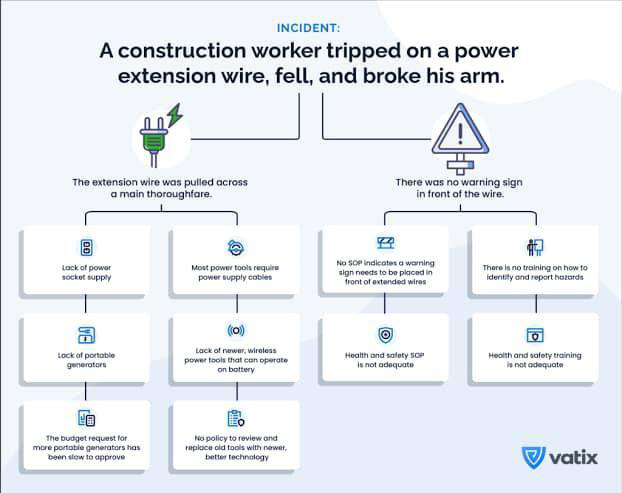
This template is used to investigate accidents and near misses. It includes an incident description, root cause identification, contributing factors, corrective actions, and lessons learned. This template is essential for organizations seeking to improve workplace safety.
By using this template, teams can identify the root causes of accidents, develop practical corrective actions, and implement measures to prevent similar incidents from occurring in the future. Additionally, this template enables teams to document lessons learned and refine their safety protocols and procedures.
Download the Accident Investigation RCA Template
8) IT Root Cause Analysis Template
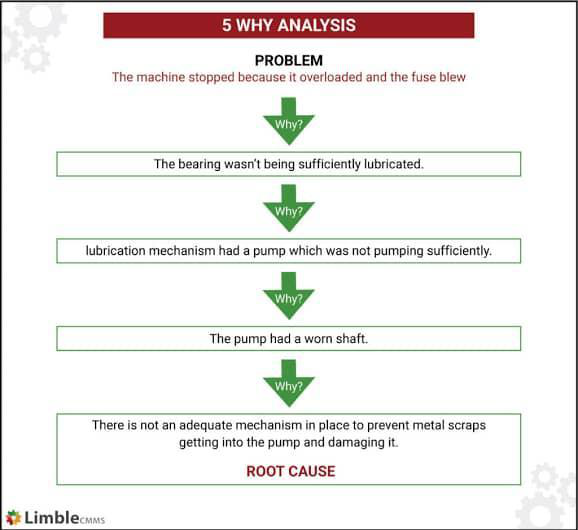
The IT root cause analysis template is designed for IT professionals to identify and address technical issues. It includes a problem description, root cause identification, technical analysis, corrective actions, and verification and validation. This template is ideal for IT teams seeking to resolve complex technical issues. This template allows IT professionals to collect and analyze data, identify patterns and trends, and develop practical solutions to technical problems.
9) Healthcare Root Cause Analysis Template
The healthcare root cause analysis template is used in healthcare settings to identify and address patient safety issues. It includes an incident description, root cause identification, preventive action, contributing factors, corrective actions, and lessons learned. This template is essential for healthcare organizations seeking to improve patient safety.
By using this template, healthcare professionals can identify the root causes of patient safety issues, develop practical corrective actions, and implement measures to prevent similar incidents from occurring in the future.
Download the Healthcare RCA Template
10) Technical Root Cause Analysis Template
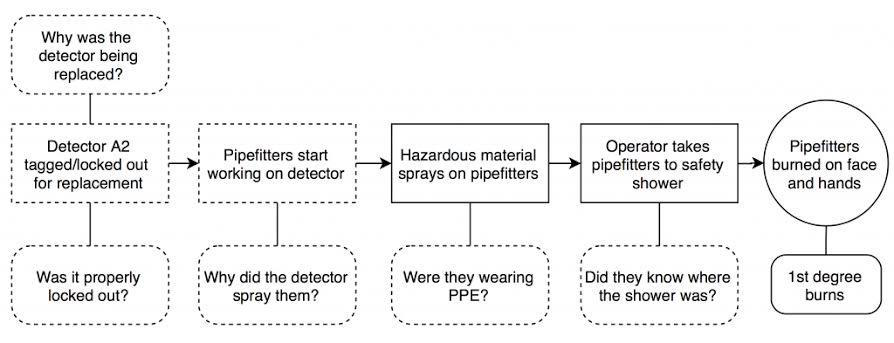
The technical root cause analysis template is a detailed template for technical problems requiring in-depth analysis. It includes a problem description, technical analysis, root cause identification, corrective actions, and verification and validation. This template is ideal for teams seeking to resolve complex technical issues that require a thorough understanding of the underlying technical factors.
This template allows teams to collect and analyze technical data, identify patterns and trends, and develop practical solutions to technical problems.
11) 8D Root Cause Analysis Template
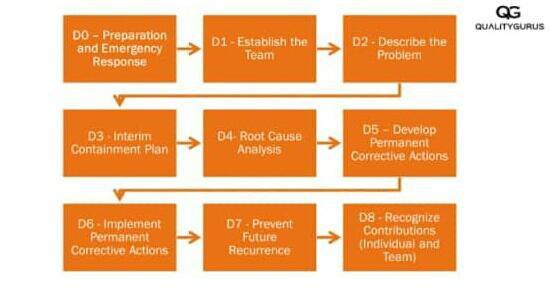
The 8D root cause analysis template is an eight-discipline template for identifying and addressing complex problems. It includes a problem description, root cause identification, containment actions, corrective actions, verification and validation, implementation and documentation, prevention and prediction, and closure and review. This template is essential for organizations seeking to resolve complex, cross-functional problems that require a structured and systematic approach.
Download the 8D Root Cause Analysis Template
These RCA templates provide a structured approach to identifying and addressing problems, enabling organizations to improve efficiency, reduce errors, and enhance overall quality. By selecting the right template for their needs, teams can ensure effective problem-solving and continuous improvement.
Key Components of an RCA Document

A well-structured RCA document is essential for effective problem-solving and continuous improvement. Below are some significant components that must not be lacking in root cause analysis documents.
Problem Statement
A well-crafted problem statement sets the stage for the entire RCA process. It clearly and concisely describes the issue or problem being analyzed. It should be specific and objective, and the problem’s scope and impact should be clearly understood. When writing a problem statement, you should clearly define the problem or issue. Note that a root cause could have multiple sources.
Next, provide context and relevant background information surrounding the problem(s). Move on to specify the impact or consequences of the problem. While on this part, avoid assumptions, biases, or blame. Lastly, keep it concise and focused. A good problem statement will help keep the RCA process focused and effective.
Data Analysis
Data analysis involves collecting and examining relevant data related to the problem. This includes gathering information from various sources, such as logs, reports, and witness statements. Data analysis helps identify patterns, trends, and relationships essential for root cause identification.
When conducting data analysis, identify relevant data sources, collect and organize the data, analyze the data to identify patterns and trends, look for correlations and relationships, and use data visualization techniques to communicate findings. You can identify key factors contributing to the problem by carefully examining the data.
Root Cause Identification
Root cause identification is the core of the RCA process. Using techniques such as the 5 Whys, or fishbone diagrams, you can identify the underlying causes of a problem. Root cause identification requires a thorough understanding of the problem, its context, and the data collected. At this point, do the following:
Use an RCA template depending on the problem you want to tackle.
Next, consider multiple possible causes and evaluate the evidence and data. At this point, avoid assumptions or biases. Finally, identify the underlying systemic or process-related issues. By understanding the underlying causes of a problem, you’ll be able to develop targeted solutions that address the root cause.
Action Items
Action items outline the specific steps necessary to address the root cause of a problem and prevent similar issues from occurring in the future. Action items should be clear, concise, and actionable, with assigned responsibilities and deadlines. Your action plan will include a clearly defined action item, a specification of the responsible individual or team, and a deadline for completion of tasks. You should also identify any necessary resources or support needed for the process. Lastly, ensure the action item addresses the potential cause. Clearly defining the actions required to address the root cause will ensure that solutions are implemented effectively.
Follow-up Plan
The follow-up plan ensures that the action items are implemented and effective. It outlines the metrics to measure success, the frequency of monitoring, and the process for reviewing and revising the action plan as needed. Your follow-up plan entails identifying the metrics to measure success, establishing a schedule for monitoring and reviewing progress, and specifying the process for revising the action plan.
By incorporating these key components, an RCA document provides a structured approach to problem-solving, enabling organizations to identify and address root causes, implement effective solutions, and achieve sustainable improvements.
SweetProcess is the software that contains all the key requirements for building your RCA. It combines collaborative team features with actionable plans, communication, deadlines, and process documentation to identify problem areas and give you desired results.
Sign up for a free trial right here.
How to Create and Manage Your RCA Using SweetProcess

SweetProcess is a process management platform designed to help organizations streamline their workflows, document standard operating procedures (SOPs), and ensure compliance. With SweetProcess, your teams can create, manage, and track processes, making it an ideal solution for managing root cause analysis (RCA). Let’s see how to create and manage your RCA using SweetProcess.
Create a Business Process
Creating a process on SweetProcess is easy. Follow these steps:
Step 1: Log in to your SweetProcess account. You’ll see a dashboard. Click on the menu and select “Processes.”
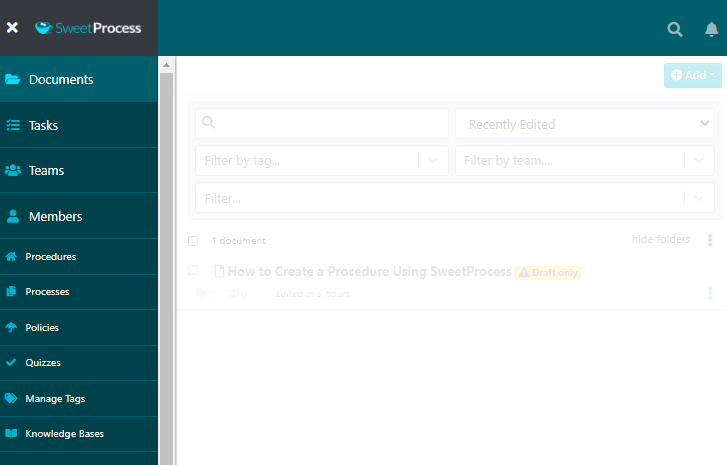
Step 2: Select ‘’Create Process’’ to begin.
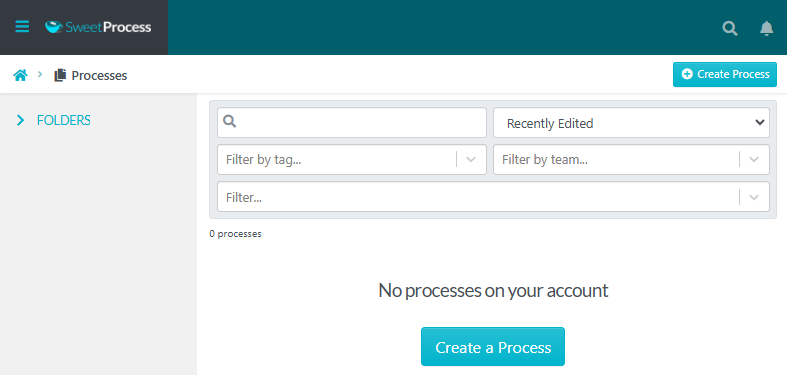
Step 3: Give your process a suitable title and click “Continue.”
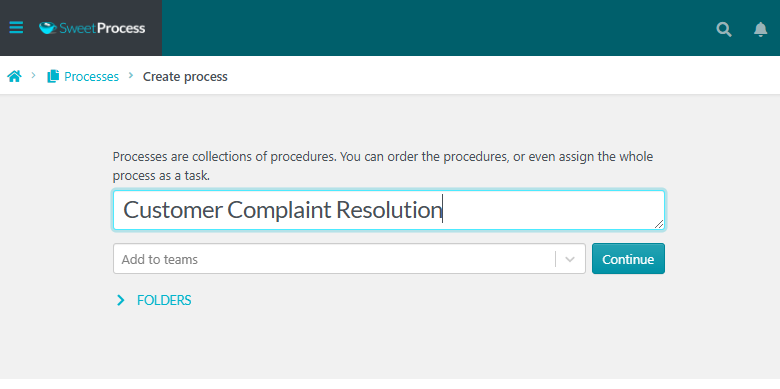
Adam Radulovic, CEO at XL.net, understood how essential processes were to a business. He understood this all too well as an IT company committed to helping businesses. Sadly, he mostly ran a confused team that tried to manage thousands of processes manually. They had over 2,500 processes within their business but were not as successful as he wanted. Rather than being efficient, employees were confused as they struggled to separate the valuable processes from the fluff.
They needed a system that could streamline their processes as quickly as possible. Discovering SweetProcess positively turned the tables. Reduced errors, happy clients, and an efficient team became the new norm in the company.
By signing up for SweetProcess, this could be you, too.
Add a Procedure to a Business Process
Your processes are incomplete without adding guides on how to get them done. Adding procedures/steps to your processes makes it easy for tasks to be completed without errors.
Step 1: Click on “Processes” from the menu bar.
Step 2: Select the process to which you want to add procedures.
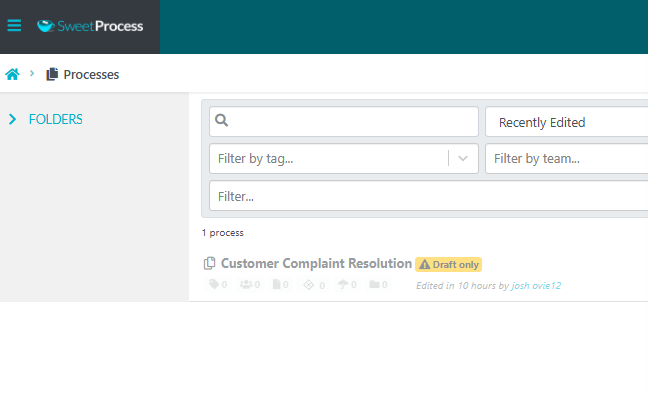
Step 3: Click on “Add new Procedure.”
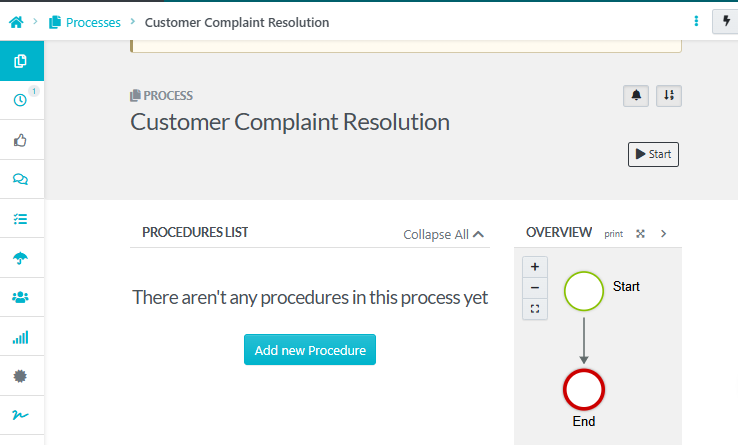
Step 4: Input as many steps as are needed to complete a process.
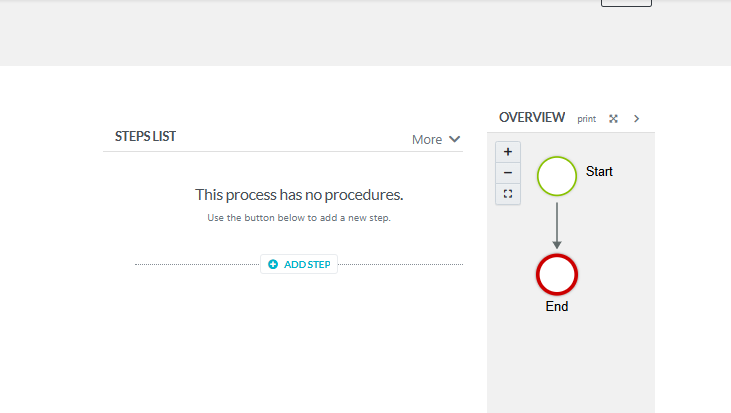
As you work on this, SweetProcess automatically creates a workflow for you. When you are done, click “End.”
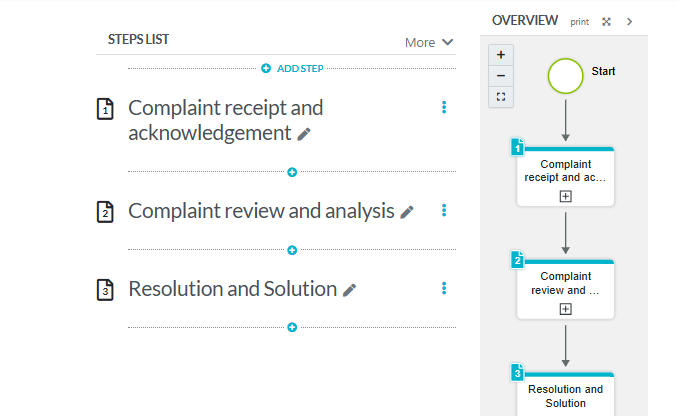
View the Version History of a Process
SweetProcess allows you to track updates and changes to your processes, making it an excellent tool for the root cause analysis process. To track changes that have been made, follow these steps.
Step 1: Select “Processes” on the menu bar.
Step 2: Select the process you want to view.
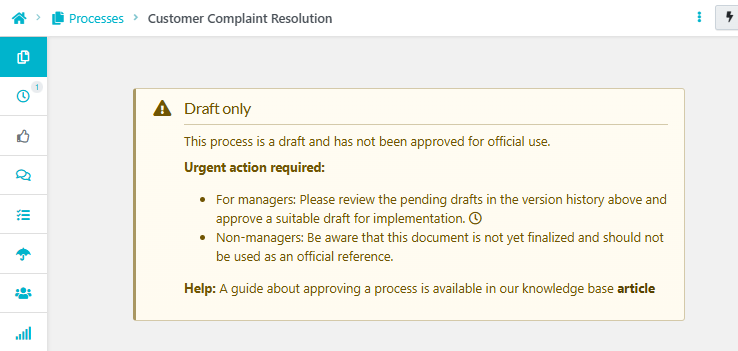
Step 3: Click on the clock icon on the menu that appears. You’ll see the history of changes made to it. Simply select the time frame you’re interested in to view that version. Once it’s approved, you can make any version go live.

Assign Tasks and Collaborate With Team Members
When working on your processes and procedures, you can assign tasks during the process or after you’re done. To do so, navigate to the “Tasks” tab on the dashboard and click the “Assign Task” button.
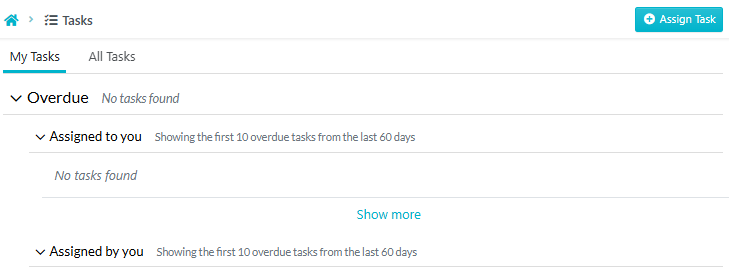
A menu with a list of existing procedures and processes will pop up. Select the document associated with the task to be assigned, and click on the “Next” button at the bottom to select the team member to be assigned the task. Before doing this, ensure you’ve already added the team member to the SweetProcess platform. After this, you can set the due date, and a notification will automatically be sent to the team member assigned.
This critical feature is a necessary tool to carry out successful RCA. Carter Harkins, co-founder of Spark Marketer, the go-to marketing agency for small and medium-sized local businesses that want to leverage digital marketing to grow their businesses, learned first-hand what it meant not to have reliable software that team members could use to produce sound and consistent results.
His employees depended on tribal knowledge to get things done; when such employees left, some knowledge was also lost. Employees went with the flow without a system to track performance, making it hard to track errors when they happened.
First, Carter needed software that could capture the business processes and procedures that team members could use and one that could assign and track tasks as well. He bumped into SweetProcess, and that’s been the end of the company’s disorganized state.
Team members no longer ask how tasks should be performed, as SweetProcess allows them to do the job independently. New employees are shown SweetProcess, and there’s never been a break in the flow.
Tips for Performing an Effective Root Cause Analysis

Following best practices and avoiding common pitfalls ensures a successful RCA. This section will examine six crucial tips for performing a practical root cause analysis, from working with a team to leveraging technology. By applying these tips, your organization can unlock the full potential of RCA and drive meaningful improvements in your operations.
Work With a Team
Performing Root Cause Analysis (RCA) can be complex and challenging. Working with a team is one of the most effective ways to ensure a successful RCA. A team-based approach brings together individuals with skills, expertise, and perspectives, enabling a more comprehensive root cause analysis method. Analysts can leverage collective knowledge, identify potential biases, and develop more effective solutions by collaborating.
When working with a team, it’s essential to establish clear roles and responsibilities, encourage open communication, and promote a collaborative environment. This can be achieved by setting clear goals and objectives, defining the scope of the analysis, and establishing a timeline for completion.
Count on Available Data
Data is the foundation of a successful RCA. Counting on available data enables you to identify patterns, trends, and correlations that can improve root cause analysis tools. When collecting data, it’s essential to consider multiple sources, including logs, reports, witness statements, and sensor data. Effective data collection requires a systematic gathering and analysis of all relevant data.
Identifying trends and patterns is a vital component of the RCA process. Various techniques, such as statistical process control, regression analysis, and data visualization, should be used.
Dig Deeper to Understand the Chain of Events
A root cause analysis is not just about identifying the immediate cause of a problem; it’s about understanding the underlying chain of events that led to the problem. To achieve this, you must ask questions like “What triggered the event?” or “What conditions contributed to the problem?” By examining the chain of events, you can identify potential vulnerabilities in processes, systems, or procedures.
Digging deeper requires persistence, curiosity, and a willingness to challenge assumptions. Various techniques, such as the 5 Whys or fishbone diagrams, can be used to identify the potential root cause of problems.
Ask Questions

Asking questions can help you identify potential human causes and develop a more thorough understanding of the problem. Various questioning techniques, such as open-ended questions, can be used to gather more information.
Focus on Where Your Impact Will Be Felt
When performing an RCA, focusing on areas where your impact will be felt is essential. This involves identifying the key factors contributing to the potential failure and prioritizing solutions that address these causal factors. By focusing on high-impact areas, you should maximize the effectiveness of your solutions, achieving more significant returns on investment and improving overall efficiency.
To focus on high-impact areas, identify the key performance indicators (KPIs) affected by the problem. Next, prioritize solutions that address these KPIs. By focusing on areas where their impact will be felt, you’ll ensure that your solutions are practical and efficient.
Leverage Technology
Technology can be a powerful tool in performing an RCA. Leveraging technology can help you collect and analyze data more efficiently, identify patterns and trends, and develop more effective solutions. Some examples of technology that can be used in RCA include data analytics software, machine learning algorithms, and collaboration tools like SweetProcess.
By leveraging technology, you’ll streamline the RCA process, reduce the risk of human error, and improve the accuracy of findings. Effective use of technology requires a clear understanding of its capabilities and limitations and the ability to integrate it into the RCA process. Consider the available tools and technologies and select the best to support your analysis techniques.
By applying these best practices, organizations can identify and address the root causes of problems, reduce the risk of future occurrences, and drive continuous process improvement in their operations.
5 Root Cause Analysis Examples to Inspire Your Team
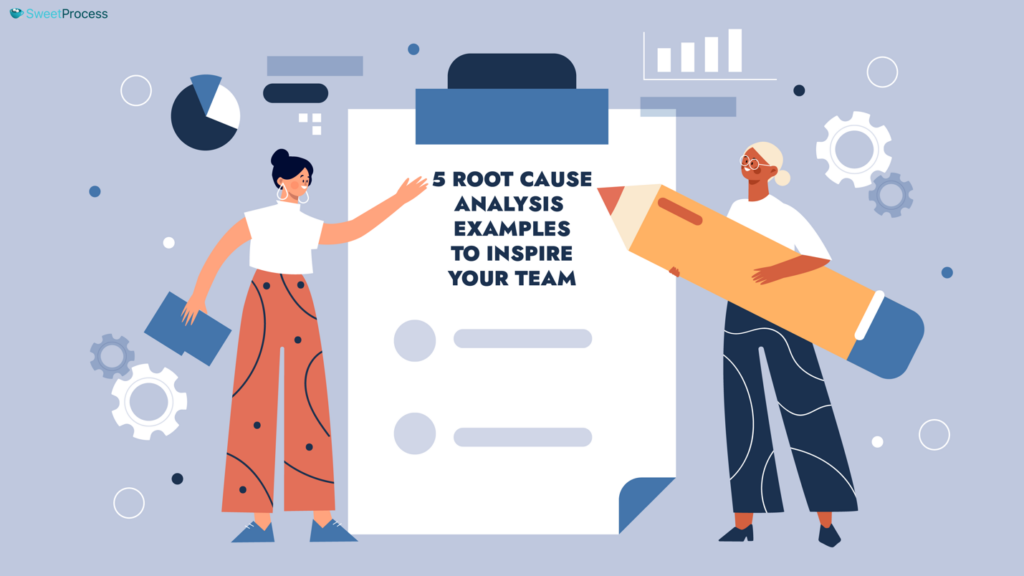
RCA for Customer Complaints
A popular online retailer known for its wide selection of products and competitive pricing received numerous complaints about delayed shipments and poor communication. Customers took to social media to express their frustration, resulting in a significant decline in customer satisfaction ratings.
The company’s customer service team was overwhelmed with complaints, and the issue was further complicated by the lack of visibility into the shipping process. The team struggled to provide accurate customer updates, further worsening the problem.
An RCA was conducted to identify the multiple root causes of the issue. The analysis revealed:
Root Cause: Inadequate staffing and training in the customer service department, combined with insufficient communication protocols.
The RCA team used the 5 Whys root cause analysis method to drill down to the root cause:
1. Why were customers complaining about delayed shipments?
Answer: Because customer service representatives were overwhelmed with calls.
2. Why were customer service representatives overwhelmed with calls?
Answer: Because there were not enough staff members to handle the volume.
3. Why were there not enough staff members?
Answer: Because the department was understaffed due to budget constraints.
4. Why were budget constraints an issue?
Answer: Because the company prioritized other departments over customer service.
5. Why did the company prioritize other departments?
Answer: Customer service was not seen as a key driver of business success.
Establishing the Team: A cross-functional team was assembled, led by the customer service manager.
Solution: Additional staff were hired, comprehensive training was given, new communication protocols and performance metrics were implemented to ensure prompt and effective resolution of customer inquiries and issues were improved.
RCA for Production Defects
A manufacturing plant producing automotive parts experienced a high rate of defective products, resulting in significant financial losses and damaging the company’s reputation. The plant’s quality control team identified several issues, including inconsistent welding, faulty machining, and incorrect assembly.
An RCA was conducted to identify the root cause of the problem. The RCA team used a fishbone diagram to identify possible causes visually:
Equipment: Inadequate maintenance, poor calibration
Materials: Substandard quality, incorrect specifications
People: Inadequate training, lack of experience
Environment: Poor lighting, inadequate ventilation
Process: Inadequate quality control, insufficient inspection
Solution: Implement enhanced quality control processes, train production staff, establish clear standards, and improve supplier quality management to detect and prevent defects.
RCA for Medication Errors
A hospital experienced a medication error that resulted in patient harm, prompting an immediate investigation. The error occurred when a nurse administered the wrong medication to a patient, resulting in a severe allergic reaction.
An RCA was conducted to identify the root cause of the problem. The RCA team used a failure mode and effects analysis (FMEA) to evaluate the medication administration process:
| Process Step | Failure Mode | Effects | Causes |
| Medication ordering | Incorrect medication | Patient harm | Lack of training, poor communication |
| Medication preparation | Incorrect dosing | Patient harm | Inadequate procedures, lack of experience |
| Medication administration | Incorrect administration | Patient harm | Lack of training, poor communication |
The root cause analysis methodology revealed:
Root Cause: Lack of standardized procedures for medication administration.
Contributing Factors: Insufficient training, inadequate staffing, and poor communication between healthcare providers.
Solution: Develop standardized procedures, provide additional training, improve communication protocols, and implement barcode scanning technology to ensure accurate and safe medication administration.
RCA for IT Outages
A company experienced an IT system outage that resulted in significant business disruption, including lost productivity and revenue. The outage occurred when a vital server failed, causing several errors throughout the system.
The IT team used a root cause analysis tree diagram to identify the underlying causes:
- IT system outage
- Inadequate system maintenance
- Lack of training
- Inadequate resources
- Insufficient disaster recovery planning
- Lack of planning
- Inadequate testing
Root Cause Found
The RCA identified inadequate system maintenance and insufficient disaster recovery planning as the root causes of IT system outages.
Contributing Factors: Lack of training, inadequate resources, and poor communication between IT teams.
Solution: Implement regular system maintenance, develop a comprehensive disaster recovery plan, provide training for IT staff, and improve communication protocols to prevent IT system outages and ensure business continuity.
RCA for Bridge Collapse
A bridge collapse caused fatalities and significant infrastructure damage, prompting a comprehensive investigation. During rush hour, a critical support beam failed, causing a section of the bridge to collapse.
An RCA was conducted to identify the possible root cause of the problem. The RCA team used a fault tree analysis (FTA) to evaluate the bridge inspection and maintenance process:
Bridge Collapse
- Inadequate inspection and maintenance
- Design flaws
- Lack of training
- Inadequate resources
- Poor communication
- Inadequate design specifications
- Lack of testing
The root cause analysis revealed:
Root Cause: Inadequate inspection and maintenance procedures, combined with design flaws.
Contributing Factors: Lack of training, inadequate resources, and poor communication between stakeholders.
Solution: Implement enhanced inspection and maintenance procedures, review and revise design standards, provide training for inspection and maintenance staff, and improve communication protocols to detect and prevent structural issues and ensure public safety.
Streamline Your RCA Process With SweetProcess

Root cause analysis is an effective way to deal with problems that may pop up in your business. By addressing the root of an issue rather than the surface, you’ll ensure the problem is permanently fixed and avoid recurrence.
Using SweetProcess to manage your root cause analysis (RCA) process can significantly improve your organization’s efficiency and effectiveness. By streamlining your RCA process, you’ll be able to identify and address problems faster, reduce errors, and improve overall quality.
With SweetProcess, you can standardize your RCA process, ensuring all stakeholders are on the same page. Our intuitive software makes it easy to document, manage, and track your RCA process so you can focus on finding and fixing problems rather than getting bogged down in paperwork. Sign up for a free trial of SweetProcess today to discover how our powerful software can help you streamline your RCA process and drive accurate results in your organization.
